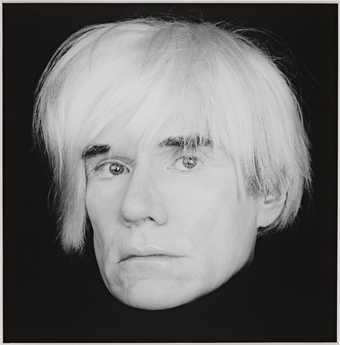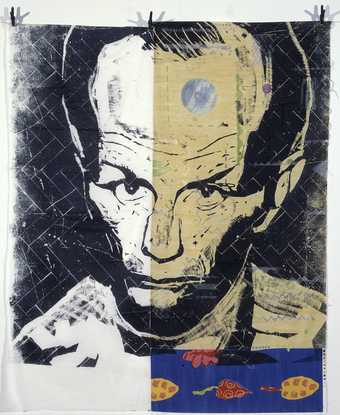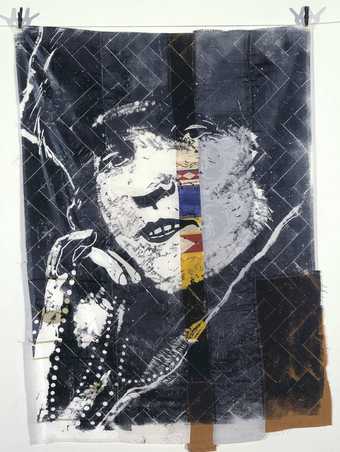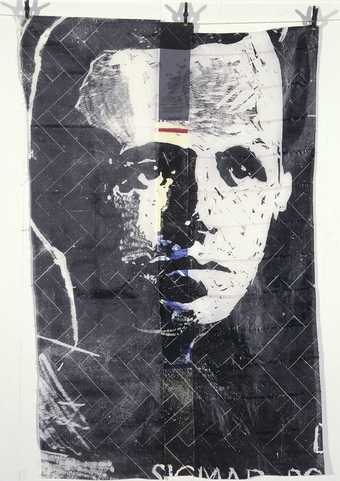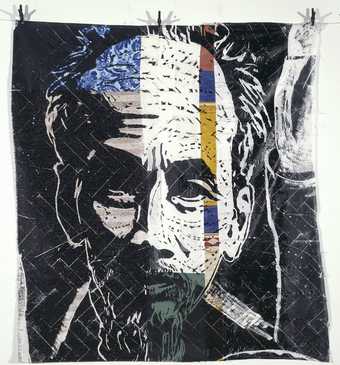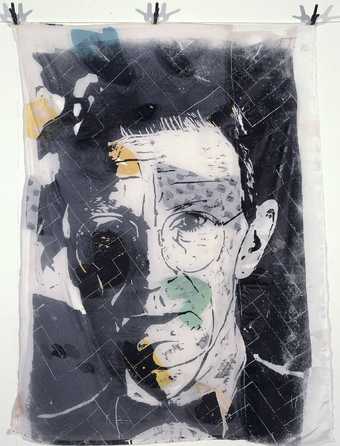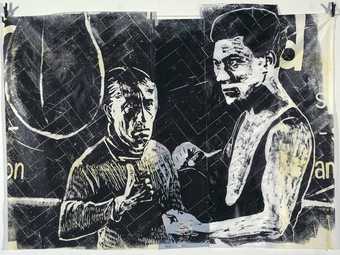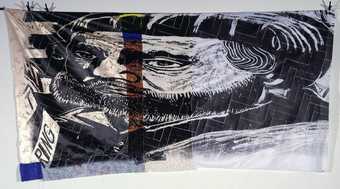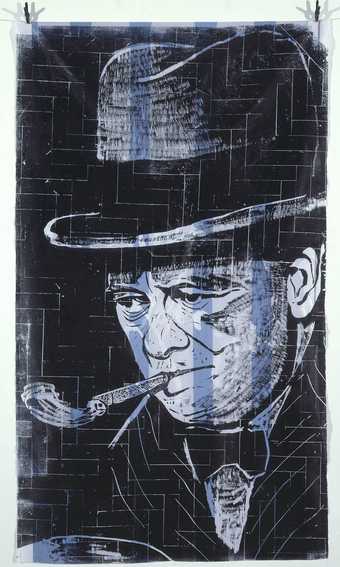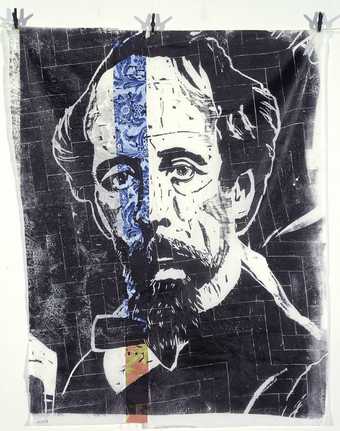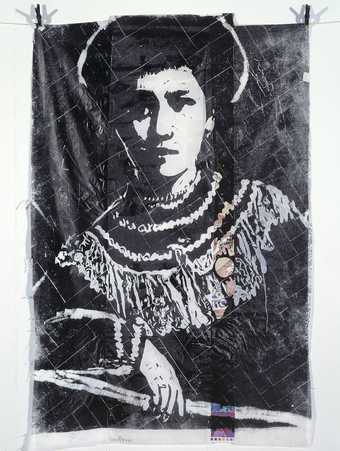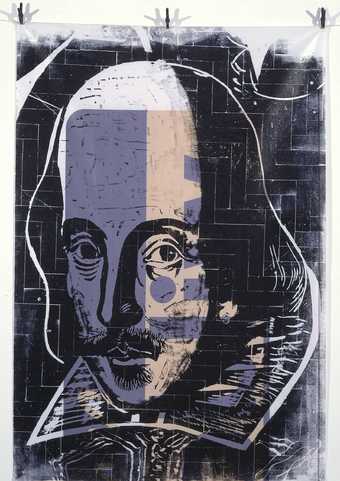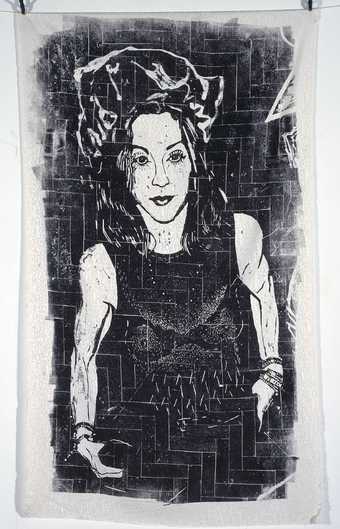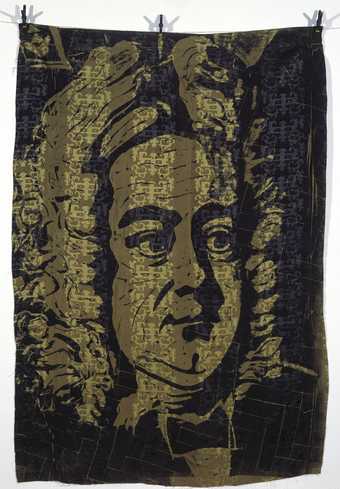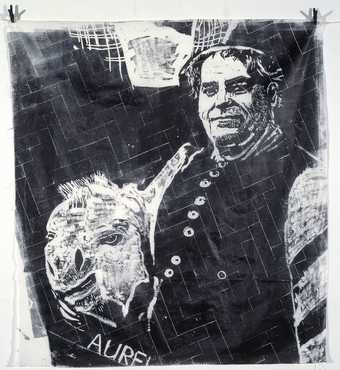
Not on display
- Artist
- Thomas Kilpper born 1956
- Medium
- Woodcut on paper
- Dimensions
- Collection
- Tate
- Acquisition
- Presented by the Friends of the Tate Gallery 2000
- Reference
- P78557
Summary
This is one of a series of unique prints generated from a site-specific work created in an office block on Blackfriars Road, in the London borough of Southwark. Orbit House was abandoned and scheduled for demolition when Kilpper gained access to the building in 1999. He carved a giant woodcut into the mahogany parquet covering the tenth floor, comprising an area of approximately 400 square metres. The woodcut depicted a boxing ring surrounded by an audience of some eighty characters whose names were cut around the edge of the image. The artist derived the portraits from photographs and etchings which he made into slides and projected onto the floor before carving the relief with chisels and a chainsaw. He then made a succession of prints, constituting individual portraits, on a range of new and found materials. He used old curtains left in the building, often sewing several pieces together to make one large, rectangular support. Paper sources include advertising hoarding paper and sheets of purple ultra violet polythene film which Kilpper discovered screening windows in some rooms of the building. The herringbone texture of the parquet features strongly on all the uncut areas of the prints which were executed mainly in black ink using a specially-made giant, cement-filled roller. During the exhibition of the work, the prints were suspended on washing lines above the carved floor. Daylight from the surrounding windows filtered through their semi-translucent supports. Visitors would walk on the carved parquet while looking at the prints. A huge banner was printed from the entire surface (The Ring, collection the artist) and hung on the outside of the building for the duration of the installation. Tate owns twenty-one prints, of which twenty are made on fabric (Tate P78537-P78556) and one, Andy Warhol and Jean Michel Basquiat Boxing, was made on paper. The Ring: Fight On (Tate T07671) is a section of the parquet flooring preserved before the building’s demolition in late 2000.
The subjects of the woodcut are characters and events in some way related to the location and to the artist. Kilpper selected Orbit House because of the fascinating history of the building and its site and their connections with his own personal history and motivations. His installation created a web of serendipitous interconnecting personal and political narratives. In 1780, the Wesleyan Surrey Chapel was erected on the site by the charismatic preacher and orator, Reverend Rowland Hill (1744-1833). It served as a chapel until 1890, when the octagonal building was taken over by first an engineering company and then a furniture warehouse. Between 1907 and 1909 it functioned as one of London’s earliest cinemas. In 1910 it became a popular boxing venue, The Ring, until 1940, when it was bombed twice in Luftwaffe raids aimed at the nearby rail link to Dover. During this period the building doubled as a soup kitchen for the poor, hosted music hall productions and was used by Alfred Hitchcock (1899-1980) as the set for his silent movie about boxers, The Ring
(1926).
Kilpper based the image, Andy Warhol and Jean Michel Basquiat Boxing, on a poster originally produced by Tony Shafrazi Gallery, New York and Bruno Bischofberger Gallery, Zurich in 1985. Advertising an exhibition of the paintings produced collaboratively by Andy Warhol (1928-87) and Jean Michel Basquiat (1960-88), the poster portrays photographs of the artists wearing boxing gloves, posing like boxers and captioned as though advertising a match. Kilpper replaced the names of the galleries presenting the artists at the top of the poster with ‘The Ring’ but reproduced the artists’ names separated by a star at the bottom of the image. As in the original, Basquiat wears shorts bearing the logo ‘Everlast’, an American sportswear brand. In the exhibition poster the two artists stand side by side, but in Kilpper’s image Warhol appears to be lunging at Basquiat from the side of the frame. Warhol was a prolific print maker. Kilpper’s portraiture in The Ring echoes Warhol’s many portraits of famous people. This print was made using red and black ink on thick white paper.
Further reading:
Thomas Kilpper: The Ring, exhibition catalogue, Orbit House, London 2000, pp.14-15
Thomas Kilpper: The Ring, exhibition brochure, South London Gallery Projects 2000
Sue Hubbard, ‘An Eye for the Bigger Picture’, Independent: The Tuesday Review, 21 March 2000
Elizabeth Manchester
September 2003
Does this text contain inaccurate information or language that you feel we should improve or change? We would like to hear from you.
Explore
- emotions, concepts and ideas(16,416)
-
- formal qualities(12,454)
-
- texture(466)
- universal concepts(6,387)
-
- humour(1,441)
- black(796)
- individuals: male(1,841)
- social comment(6,584)
-
- caricature(355)
- inscriptions(6,664)
-
- name of sitter(44)
- phrase(100)
- arts and entertainment(7,210)
-
- artist, painter(2,545)
- boxer(18)
You might like
-
Robert Mapplethorpe Andy Warhol
1986 -
Thomas Kilpper The Ring: Henry Cooper
2000 -
Thomas Kilpper The Ring: Marie Lloyd
2000 -
Thomas Kilpper The Ring: Dick Burge
2000 -
Thomas Kilpper The Ring: Ho Chi Minh
2000 -
Thomas Kilpper The Ring: Nicholas Serota
2000 -
Thomas Kilpper The Ring: Gordon Harker
2000 -
Thomas Kilpper The Ring: Hans Holbein
2000 -
Thomas Kilpper The Ring: Winston Churchill
2000 -
Thomas Kilpper The Ring: Charles Dickens
2000 -
Thomas Kilpper The Ring: Louisa Raeburn
2000 -
Thomas Kilpper The Ring: William Shakespeare
2000 -
Thomas Kilpper The Ring: Madonna
2000 -
Thomas Kilpper The Ring: G. F. Handel
2000 -
Thomas Kilpper The Ring: Robert Atkins
2000

